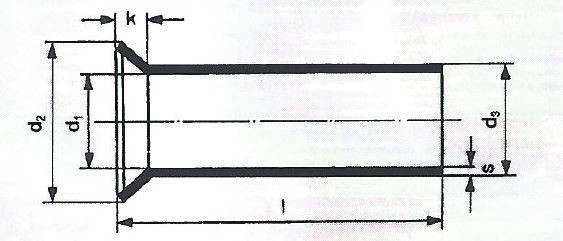| sleeve code | cable cross-section mm2 | length I | d1 | d2 | d3 | k max. | S ± 0,05 |
| H 0,5 | 0,50 | 6 | 1 | 2,1 | 1,3 | 0,7 | 0,15 |
| H 0,75 |
0,75 0,75 0,75 |
6 8 10 |
1,4 | 2,5 | 1,7 | 0,7 | 0,15 |
| H 1 |
1 1 |
6 10 |
1,6 | 2,7 | 1,9 | 0,7 | 0,15 |
| H 1,5 |
1,5 1,5 |
7 10 |
1,8 | 2,9 | 2,1 | 1 | 0,15 |
| H 2,5 |
2,5 2,5 |
7 12 |
2,3 | 3,5 | 2,6 | 1 | 0,15 |
| H 4 |
4 4 |
9 12 |
2,8 | 4 | 3,2 | 1 | 0,2 |
| H 6 |
6 6 6 |
10 12 15 |
3,6 | 4,8 | 4 | 1 | 0,2 |
| H 10 |
10 10 10 |
12 15 18 |
4,5 | 5,8 | 4,9 | 1,2 | 0,2 |
| H 16 |
16 16 16 |
12 15 18 |
5,8 | 7,5 | 6,2 | 1,5 | 0,2 |
Contacts

Tubular end-sleeves or ferrules are used when a perfect connection at the end of the cable is required. The purpose of end sleeves is to connect the wire and the terminal. With end sleeves from Rona Kranj, you reduce the risk of cable breakage. In addition, they create a large contact area. They are usually made of copper and are tinned. Dimensions and tolerances are determined by the DIN46228 standard.

